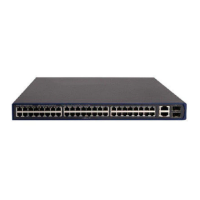67
Displaying and maintaining SNMP
To do… Use the command… Remarks
Display SNMP agent system
information, including the contact,
physical location, and SNMP
version
display snmp-agent sys-info [ contact |
location | version ]* [ | { begin |
exclude | include } regular-expression ]
Available in any view
Display SNMP agent statistics
display snmp-agent statistics [ | { begin
| exclude | include }
regular-expression ]
Available in any view
Display the local engine ID
display snmp-agent local-engineid [ |
{ begin | exclude | include }
regular-expression ]
Available in any view
Display SNMP group information
display snmp-agent group
[ group-name ] [ | { begin | exclude |
include } regular-expression ]
Available in any view
Display basic information about
the trap queue
display snmp-agent trap queue [ |
{ begin | exclude | include }
regular-expression ]
Available in any view
Display the modules that can send
traps and their trap status (enable
or disable)
display snmp-agent trap-list [ | { begin
| exclude | include }
regular-expression ]
Available in any view
Display SNMPv3 user information
display snmp-agent usm-user
[ engineid engineid | username
user-name | group group-name ] * [ |
{ begin | exclude | include }
regular-expression ]
Available in any view
Display SNMPv1 or SNMPv2c
community information
display snmp-agent community [ read
| write ] [ | { begin | exclude |
include } regular-expression ]
Available in any view
Display MIB view information
display snmp-agent mib-view [ exclude
| include | viewname view-name ] [ |
{ begin | exclude | include }
regular-expression ]
Available in any view
SNMP configuration examples
SNMPv1/SNMPv2c configuration example
Network requirements
As shown in Figure 25, the NMS (1.1.1.2/24) uses SNMPv1 or SNMPv2c to manage the SNMP agent
(1.1.1.1/24), and the agent automatically sends traps to report events to the NMS.

